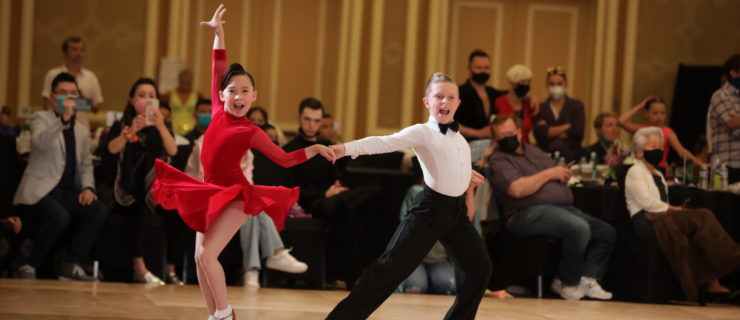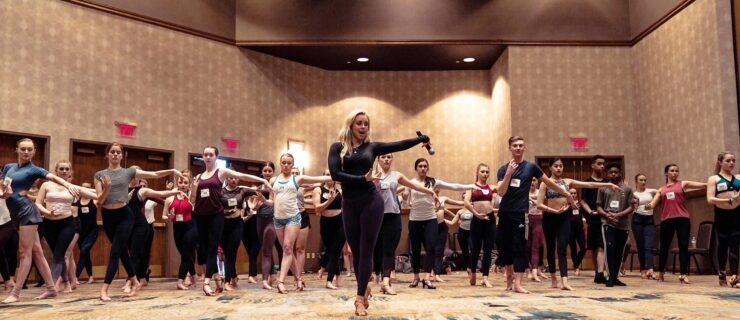Ballroom Basics
With TV and movies exposing ballroom dance like never before—and competition routines incorporating the artform at unprecedented rates—now’s the perfect time to add the waltz, jive, cha-cha and more to your repertory. Check out these tips on picking up social dance, from learning how to follow to observing proper etiquette.
From Classroom to Club
Whether you’re taking ballroom for the first time or brushing up on the basics, work should take place both in and outside the studio. Talia Castro-Pozo, co-director of New York City’s Stepping Out Studios, recommends learning a little about each dance you’ll be studying before you even step into the classroom. “You’ll get more out of class time if you’re not thinking about technique,” she explains. If you can, pack in the lessons—both privates and group partnering sessions—so that you have less time to pick up bad habits. Castro-Pozo also gives students exercises to work on at home, though she cautions that practicing moves you’re uncertain about may cause you to memorize steps incorrectly. “And practice with many partners,” she adds. This will not only prevent you from falling into a comfort zone, but also challenge you to find the perfect complement. “Try many partners, because any coupling might work,” she says. “Two beginners can work together, or a beginner and a more experienced leader.”
Once you feel good about your progress—and have a partner you feel comfortable with—practice in a social setting like a dance club or salsa party at a dance studio. “In [reality], ballroom dances take place on crowded floors with low lights and loud music,” Castro-Pozo says. “Many of these dances move at a fast pace, so you have to know how to keep the tempo while maneuvering around other couples.” Follow the Leader One of the biggest challenges facing female ballroom neophytes is learning how to follow the man’s lead. Avoid these common mistakes and you’ll be on your way to forming the perfect partnership.
1. Wet noodle syndrome:
Lifeless arms, soft shoulders and a body lacking in energy makes it difficult for the guy to lead. “A good follower should have resistance in her arms so when her partner pushes, she must respond,” says Peri Judith, a ballroom dance instructor at 3rd Street Dance in L.A. who has 30 years of teaching experience. “She should have the control of a Cadillac. Just a light touch of her steering wheel—her hands—and she should move.”
2. Pushing back:
When the leader pushes, the follower should respond, or follow, but not push, even though that may be a natural reaction to having someone enter her space. “The follower must learn to relax, translate his message and respond with the appropriate movement,” Judith says.
3. Trying to lead:
This sounds almost too easy, but, Castro-Pozo says, “Modern women love to lead. And there can’t be two leaders.” Lee Smith, dance director at BlueRidge Ballroom Dance Studio in Asheville, NC, adds, “If you’re thinking about the pattern and what comes next, you’re not following. If he leads the dance wrong, do it wrong. That’s following.”
4. Anticipating his movements:
Even if you think you know where the dance could take you, wait for your partner to take you there. “That’s the fun of ballroom dance,” Judith says. “Not knowing what’s next, but creating movement based on the message your partner sends.”
Etiquette Lesson
Etiquette is an important part of ballroom dance, especially when practiced in a social setting. When you’re not alone on the dance floor, keep the following things in mind:
- If someone asks you to dance, try to say yes as often as possible. It’s especially rude to refuse one partner and accept another for the same dance.
- Have character—shoes, that is. It’s important to learn to dance in heels, since that’s the proper footwear.
- Dress appropriately—for women, that means wearing a skirt. “It helps with the movement and adds to the cultural cachet of ballroom,” Castro-Pozo says, adding that matching your outfit to the style you’re dancing can help you get into character.
- Be aware! Important as it is to pay attention to your partner’s lead, it’s equally essential to pay attention to where other couples are on the dance floor.
Alyssa Roenigk is a NYC-based journalist who also writes for ESPN: The Magazine.


